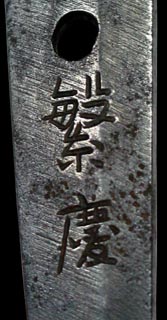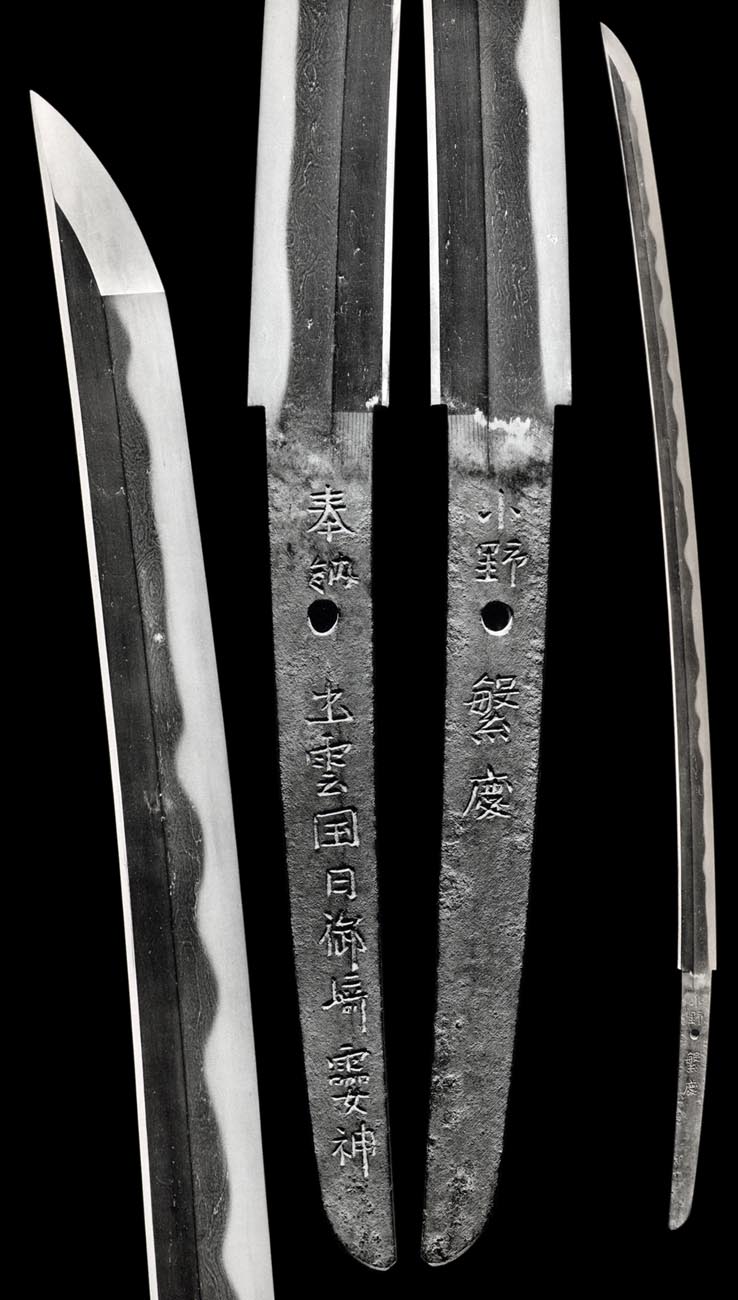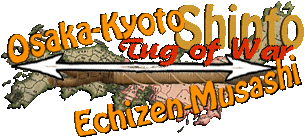EDO - MUSASHI PROVINCE
NODA
______
HANKEI GEN-WA 1615
|__________
____|____ ____|____
SHIGEMASA MASAYOSHI
HANSHO SEIKEI
|

|
Hankei
swords are extremely rare.
Known as "Masamune (of)
Shinto". Almost all
Hankei were created for the
Tokugawa, and almost all
Hankei were owned by the
Tokugawa. The Tokugawa
family and Hankei have
always been linked as Hankei
was Iyeyasu's favored smith
of both Guns and Sword.
The
reasons are several. Hankei
was from Mikawa, Iyeyasu's
home province.
He
was perhaps the greatest gun
smith of the era, known as
an utter genius. His
gun-smith name was Noda
Zenjiro Kiyotaka.
Scholarship
has argued why such a great
Gun smith should then make
swords. Iyeyasu commanded
him to revert to make guns
for the Osaka Summer and
Winter Campaigns.
Hankei's
work is rare. His group is
small; his student,
Hansho's work is rare and
the work of Seikei almost
never found.
HANKEI: O-ITAME MASA which
can be rough. SUGU KO-MIDARE,
GUNOME-MIDARE,
NOTARE, O-MIDARE with KINSUJI and
INAZUMA. CHIKEI. SOSHU style. HANKEI
likened to MASAMUNE. Both
blade-making and signature are
recognized as having an early and
late style period. One source argues he
was born in MIKAWA. He lived
temporarily at HACHIOJI, BUSHU. His
name was NODA ZENSHIRO KIYOTAKA and
is also called NODA ZEN
KIYOTAKA and his classic sword MEI
is HANKEI.
He came from a family
of gunsmiths. He has a unique
quality to his steel, a hardness is
seen in a blend of O-ITAME
that runs. This appears like the
famous MATSUKAWA "Pine
Bark" HADA, a running appearance
where wide, expanded O-HADA
mixes with defined and complex,
running grain lines. His steel is
KURO or dark. It appears like the
dark of night.His will be
standing HADA with JI-NIE
which has long been compared to MASAMUNE
or NORISHIGE and is speculated that
he not only re-created
their ideal but surpassed them in
taking the next steps in in their
technological drive.
Swords
signed KIYOTAKA are few and
should show a an even NOTARE, GUNOME mix in
NIE-DEKI with ARA-NIE that is
comparatively defined and clear.
NIOI-GUCHI seems defined.
Swords
signed HANKEI are O-MIDARE,
KO-MIDARE, KO-NOTARE mixed with GUNOME HA
where NIE and HOTSURE are
exceptionally strong and the NIOI-GUCHI is
wide. SUNAGASHI repeats wherein
KINSUJI will be found. HAMON is
NIE-DEKI with ARA-NIE reminding of
the SOSHU style of
NORISHIGE.
The
HAMON above the YOKOTE is wide and
large in HAKIKAKE that sometimes seems
YAKIZUME but mostly a long fall in a
near MUNEYAKI. His
large BOSHI will often nearly become
ICHIMAE.
His large BOSHI will often nearly
become ICHIMAE.
Hankei
Ono Hankei
Gun signatures:
Kiyotaka
Noda Zen Kiyotaka
Nihon Zen Kiyotaka
|
|
|

Juyo
Bunkazai Hankei
Nagasa: 2 Shaku 3 Sun 6 Bu (71.51cm)
Moto-Haba: 1 Sun (3.03cm)
Nakago: 6 Sun 4 Bu (19.54cm)
Gift to the Izumo
Hinomisaki Jinja
Shinogi-Tsukuri,
Mitsu-Mune, shallow Sori,
elongated Chu-Kissaki.
Strongly standing and roughly
forged Itame-Masame, Mokume
Hada with Ji-Nie and twisting
Chikei.
Nioi-Fukashi and Nie, Midare
of Gunome-Midare with
Sunagashi and Kinsuji.
Kaen Flame Boshi one Hakikake.
Ubu Haagari Yagengata Nakago
has two Mekugi-ana. In his
thick, gouged out strokes.
Hono
Izumo-no-Kuni Hinomisaki
Reijin
Ono Hankei
|

